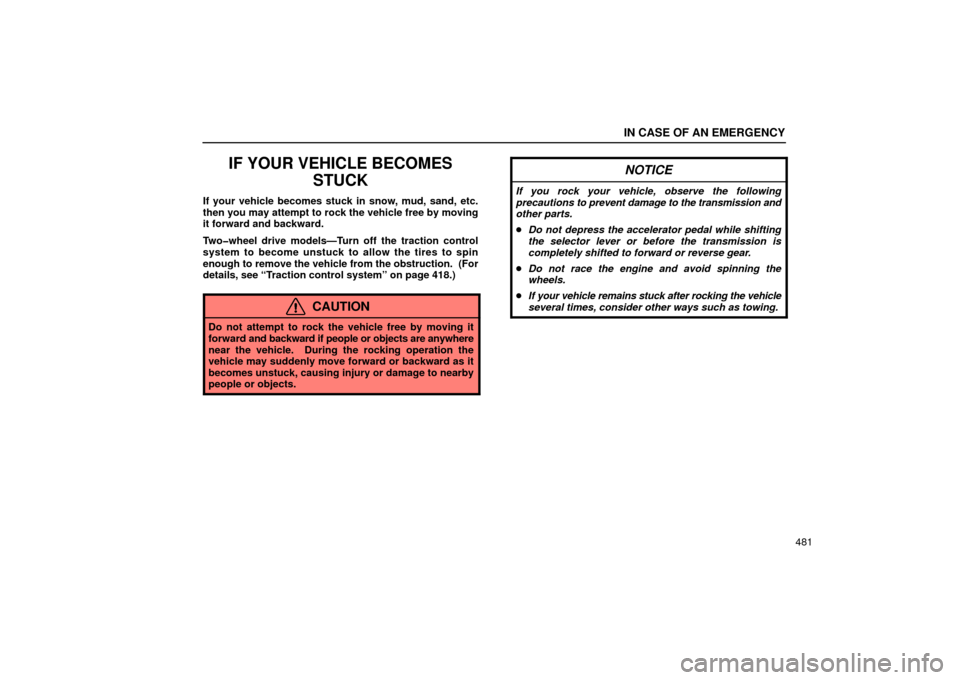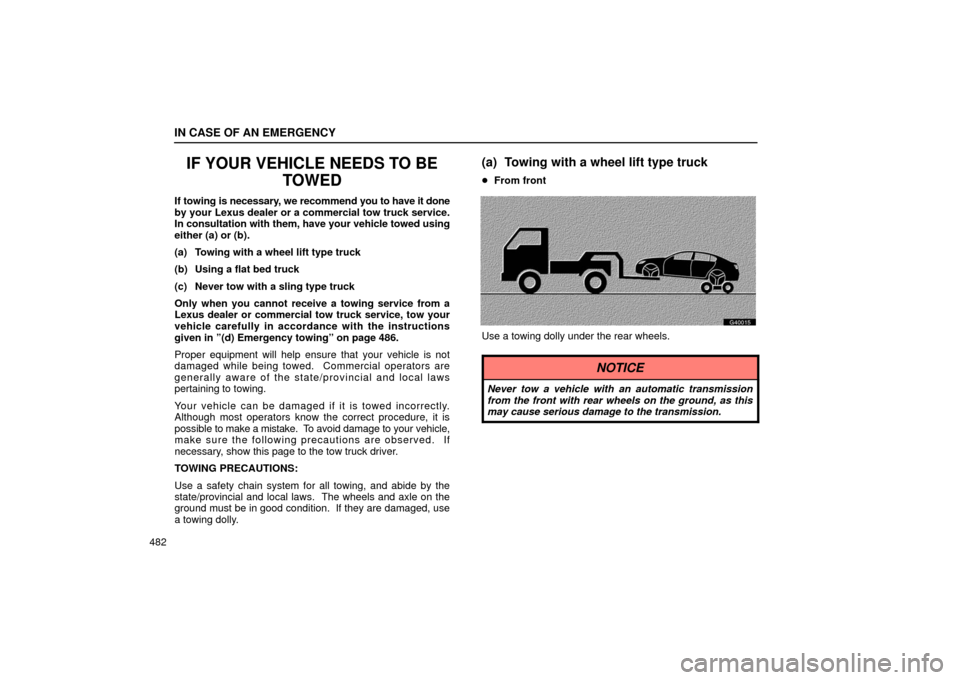Page 492 of 622

IN CASE OF AN EMERGENCY
471
Compact spare tire
G40025
The compact spare tire is designed for temporary
emergency use only.
The compact spare tire is identified by the distinctive
wording “TEMPORARY USE ONLY” molded into the
side wall of the tire.
To keep the compact spare tire noticeable, do not hide
the wheel by a wheel cover or such.
The compact spare tire saves space in your luggage
compartment, and its lighter weight helps to improve fuel
economy and permits easier installation in case of a flat
tire. The compact spare tire is not equipped with the tire
pressure sensor
. If tire inflation pressure becomes low,
the tire pressure warning system will not be activated.
Also, if you replace the compact spare tire after the low
tire pressure warning light comes on, the light remains
on.
The compact spare tire can be used many times, if
necessary. It has tread life of up to 4800 km (3000 miles)
depending on road conditions and your driving habits.
When tread wear indicators appear on the tire, replace
the tire. (See “Checking and replacing tires” on page
554.)
Page 496 of 622
IN CASE OF AN EMERGENCY
475
G40006
� 1 Joint
2 When removing the jack, turn the joint by hand inthe ”contract” direction until the jack is free.
3 When storing, turn the joint by hand in the”expand” direction until the jack is firmly secured
to prevent it from flying forward during a collision
or sudden braking.
G40024
To remove the spare tire:
1Remove the luggage tray.
2Loosen the bolt and remove it.
When storing the spare tire, place it with the outer side
of the wheel facing up. Then bolt the tire in place and
install the luggage tool box to prevent the tire from flying
forward during a collision or sudden braking.
Page 497 of 622
IN CASE OF AN EMERGENCY
476
G40007
4. Block the wheel diagonally opposite the flat tire to
keep the vehicle from rolling when it is jacked up.
When blocking the wheel, place a wheel block in front of
one of the front wheels or behind one of the rear wheels.
G40008
5. Loosen all the wheel nuts.
Always loosen the wheel nuts before raising the vehicle.
Turn the wheel nuts counterclockwise to loosen them.
To get maximum leverage, fit the wrench to the nut so
that the handle is on the right side, as shown above.
Grab the wrench near the end of the handle and pull up
on the handle. Be careful that the wrench does not slip
off the nut.
Do not remove the nuts yet − just unscrew them about
one−half turn.
CAUTION
Never use oil or grease on the bolts or nuts. The
nuts may loosen and the wheels may fall off, which
could cause a serious accident.
Page 499 of 622
IN CASE OF AN EMERGENCY
478
G40011
8. Remove the wheel nuts and remove the flat tire.
Lift the flat tire straight off and put it aside.
G40012
Before putting on the wheel, remove any corrosion on
the mounting surfaces with a wire brush or such.
Installation of wheels without good metal−to− metal
contact at the mounting surface can cause wheel nuts to
loosen and eventually cause a wheel to come off while
driving.
Page 500 of 622

IN CASE OF AN EMERGENCY
479
G40013
9. Reinstall all the wheel nuts finger tight.
Align the holes in the wheel with the bolts. Then lift up
the wheel and get at least the top bolt started through its
hole. Wiggle the tire and press it back over the other
bolts.
Reinstall the wheel nuts and tighten them as much as
you can by hand. Press the tire back and see if you can
tighten them more.
CAUTION
Never use oil or grease on the bolts or nuts. Doing
so may lead to overtightening the nuts and
damaging the bolts. The nuts may loosen and the
wheels may fall off, which could cause a serious
accident. If there is oil or grease on any bolt or nut,
clean it.
G40014
10. Lower the vehicle completely and tighten the
wheel nuts.
Turn the jack handle counterclockwise to lower the
vehicle.
Use only the wheel nut wrench to tighten the nuts. Do
not use other tools or any additional leverage other than
your hands, such as a hammer, pipe or your foot. Make
sure the wrench is securely engaged over the nut.
Tighten each nut a little at a time in the order shown.
Repeat the process until all the nuts are tight.
Page 501 of 622

IN CASE OF AN EMERGENCY
480
CAUTION
�When lowering the vehicle, make sure all
portions of your body and all other persons
around will not be injured as the vehicle is
lowered to the ground.
� Have the wheel nuts tightened with torque
wrench to 103 N·m (10.5 kgf·m, 76 ft·lbf.), as
soon as possible after changing wheels.
Otherwise, the nuts may loosen and the wheels
may fall off, which could cause a serious
accident.
� Do not attach a heavily damaged plastic wheel
ornament. It may fly off the wheel and cause
accidents while the vehicle is moving.
11. After changing the wheel, check the air
pressure of the replaced tire. Stow all the tools, jack
and flat tire securely.
If the inflation pressure of the replaced tire is low, drive
slowly to the nearest service station and fill to the correct
pressure.
Do not forget to reinstall the tire valve cap as dirt and
moisture could get into the valve core and possibly
cause air leakage. If the cap is missing, put a new one
on as soon as possible.
This is the same procedure for changing or rotating your
tires.
CAUTION
Before driving, make sure all the tools, jack and
flat tire are securely in place in their storage
location to reduce the possibility of personal
injury during a collision or sudden braking.
Page 502 of 622

IN CASE OF AN EMERGENCY
481
IF YOUR VEHICLE BECOMESSTUCK
If your vehicle becomes stuck in snow, mud, sand, etc.
then you may attempt to rock the vehicle free by moving
it forward and backward.
Two�wheel drive models—Turn off the traction control
system to become unstuck to allow the tires to spin
enough to remove the vehicle from the obstruction. (For
details, see “Traction control system” on page 418.)
CAUTION
Do not attempt to rock the vehicle free by moving it
forward and backward if people or objects are anywhere
near the vehicle. During the rocking operation the
vehicle may suddenly move forward or backward as it
becomes unstuck, causing injury or damage to nearby
people or objects.
NOTICE
If you rock your vehicle, observe the following
precautions to prevent damage to the transmission and
other parts.
� Do not depress the accelerator pedal while shifting
the selector lever or before the transmission is
completely shifted to forward or reverse gear.
� Do not race the engine and avoid spinning the
wheels.
� If your vehicle remains stuck after rocking the vehicle
several times, consider other ways such as towing.
Page 503 of 622

IN CASE OF AN EMERGENCY
482
IF YOUR VEHICLE NEEDS TO BETOWED
If towing is necessary, we recommend you to have it done
by your Lexus dealer or a commercial tow truck service.
In consultation with them, have your vehicle towed using
either (a) or (b).
(a) Towing with a wheel lift type truck
(b) Using a flat bed truck
(c) Never tow with a sling type truck
Only when you cannot receive a towing service from a
Lexus dealer or commercial tow truck service, tow your
vehicle carefully in accordance with the instructions
given in ”(d) Emergency towing” on page 486.
Proper equipment will help ensure that your vehicle is not
damaged while being towed. Commercial operators are
generally aware of the state/provincial and local laws
pertaining to towing.
Your vehicle can be damaged if it is towed incorrectly.
Although most operators know the correct procedure, it is
possible to make a mistake. To avoid damage to your vehicle,
make sure the following precautions are observed. If
necessary, show this page to the tow truck driver.
TOWING PRECAUTIONS:
Use a safety chain system for all towing, and abide by the
state/provincial and local laws. The wheels and axle on the
ground must be in good condition. If they are damaged, use
a towing dolly.
(a) Towing with a wheel lift type truck
� From front
G40015
Use a towing dolly under the rear wheels.
NOTICE
Never tow a vehicle with an automatic transmission
from the front with rear wheels on the ground, as this
may cause serious damage to the transmission.